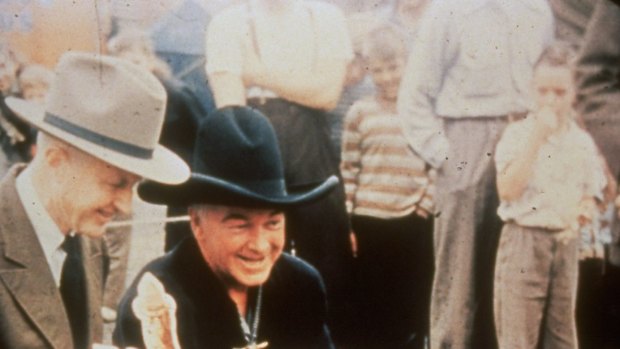This was published 9 years ago
The real Smokey Bear: How a cute bear cub saved millions of lives

The real Smokey Bear meets his cartoon likeness in 1950.Credit: Getty Images
In south-eastern New Mexico, David Whitley discovers the story of a much-loved American icon – Smokey Bear.
Find any more than two trees clumped together in the United States, and you're more than likely to have encountered Smokey Bear. He stands stoutly, with his spade and his ranger's hat, on signs that keep you up to date with the fire risk on any given day. He's America's icon of fire safety, and he'll always let you know whether it's considered safe to go down in the woods today.
Few fictional creatures are so respected and beloved. Except, as it turns out, Smokey is not entirely fictional.
On the way through south-eastern New Mexico, a little speck on the map grabs my attention. The Smokey Bear Historical State Park lies in the middle of the forested, mountainous country more readily associated with Billy The Kid.
But this is where the real Smokey comes from, and a small visitor centre tells his tale.
In 1950, a massive wildfire was raging through the Lincoln National Forest, with 17,000 acres ablaze and many firefighters trapped in the inferno. Then one of them found a little bear cub – no more than a few months old – clinging to an aspen tree. He was separated from his mother, and had badly burned paws. The photos – which are almost unimaginably cute – went first to the local papers, and then nationwide. The bear was flown to Santa Fe, then nursed back to health. The game warden who rescued him, Ray Bell, decided to name his patient after the bear from the fire prevention posters.
Those posters first made an appearance in 1944, when the Cooperative Forest Fire Prevention Campaign was putting out wartime ads to save timber by preventing unnecessary fires. A bear was picked as a mascot instead of the proposed squirrel or owl as it was one of the few creatures big enough to put out a fire in roughly the same way that a human would. The ranger's hat was chosen as a sign of trustworthy authority, and the spade was picked as the best tool for putting out campfires properly.
By 1946, artist Rudy Wendelin had been appointed as the official caretaker of the Smokey Bear image. In his lifetime, he produced over 4000 pieces of art featuring Smokey.
The poor cub trapped in the Lincoln National Forest fire came along at the right time. Wouldn't it be good, the powers that be decided, to have a living embodiment of the bear from the fire safety campaigns? So the rescued cub was given a new home – the National Zoo in Washington DC.
And boy did he become popular. In 1964, he was given his own secretary to handle all the mail he was getting. He also got his own postcode – he was getting more letters than any other individual in Washington DC, including the US president.
But behind the cuteness is an astonishing success story. Few marketing campaigns in history have been so successful. A 1968 survey showed that 98 per cent of American children and 94 per cent of adults recognised Smokey and the nature of his message. Figures are similar today.
In 1992, the Forest Service estimated that accidental, human-caused fires had reduced by half since the campaign began. That's despite ten times as many people visiting public lands and a huge increase in the number of homes built on the cusp of forests.
As for the real life Smokey, he was retired as the real life symbol of the campaign in 1975. He was 25 years old – which in North American black bear terms is the equivalent of 70 human years. That's the mandatory retirement age for federal employees, and Smokey was always a stickler for the rules. He died a year later, and was flown back to El Capitan, the little town where the State Park's visitor centre is.
A walking trail outside leads through plenty of native New Mexican plants before emerging at a big rock. A plaque embedded in it briefly tells the tale of the most remarkable bear that ever lived. It's Smokey's gravestone. Rest in peace, little fella.
The writer paid for his own travel.
The Smokey Bear State Historical Park (smokeybearpark.com) is in the village of Capitan, 280km south-east of New Mexico's largest city and major hub, Albuquerque. It's on the way to supposed UFO hotspot Roswell. Opening hours are 9am to 5pm.
Sign up for the Traveller Deals newsletter
Get exclusive travel deals delivered straight to your inbox. Sign up now.